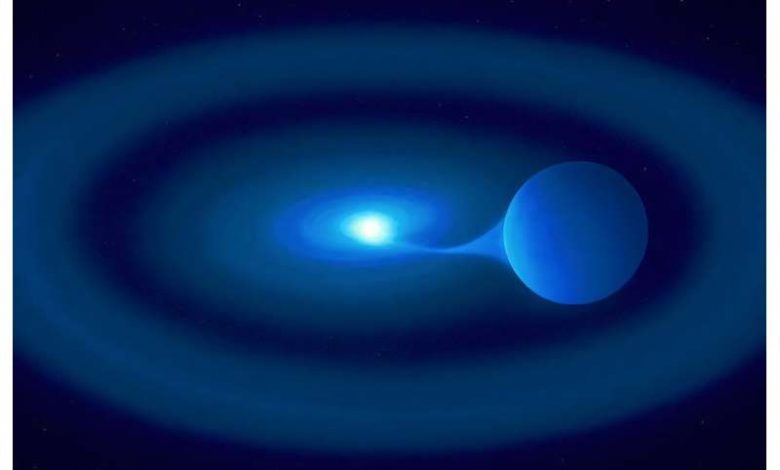This star is consuming its companion and could explode brilliantly

Binary star systems are not rare. Neither are systems where one star is a remnant like a white dwarf or neutron star, and its companion is on the main sequence. In those systems, the dense remnant can draw material away from the main sequence star. This can create violent Type 1a supernovae in the case of a white dwarf, and the emission of extremely powerful X-rays in the case of a neutron star.
In new research, astronomers observed the cataclysmic variable binary star V Sagittae (V Sge). It’s extremely bright for its type, indicating that the accretor star is drawing an enormous amount of material from the donor, which gathers on the surface of the accretor before igniting and flaring brightly.
The research, “V Sge: Supersoft Source or Exotic Hot Binary? I. An X-Shooter campaign in the high state” is published in the journal Monthly Notices of the Royal Astronomical Society. The lead author is Pasi Hakala from the Finnish Center for Astronomy with ESO.
V Sge has a main sequence star with about 3.3 solar masses, which is the donor star in the pair. The other star is the accretor, and while astronomers thought it was a white dwarf for a long time, more recent observations suggest that it’s a Wolf-Rayet star, which are closely related to white dwarfs. V Sge is unusual and has puzzled astronomers for decades.
“V Sagittae is no ordinary star system—it’s the brightest of its kind and has baffled experts since it was first discovered in 1902,” said Professor Phil Charles from Southampton University, who was involved with the study.
“Our study shows that this extreme brightness is down to the white dwarf sucking the life out of its companion star, using the accreted matter to turn it into a blazing inferno. It’s a process so intense that it’s going thermonuclear on the white dwarf’s surface, shining like a beacon in the night sky.”
Its optical emissions are highly variable and extremely complex. Astrophysicists have struggled to interpret its characteristics, and they’ve been observing the star for a long time. However, the new observations in this work revealed a circumbinary ring that helps explain what’s going on.
The circumbinary ring wasn’t captured visually. The researchers gathered spectra of V Sge with the X-Shooter, a powerful spectrograph on ESO’s Very Large Telescope in Chile. The emission lines they observed, including the velocities they revealed, can’t be explained by the stars themselves.
“More importantly, (a) this feature does not vary with orbital phase, and (b) is centered at the systemic velocity, meaning that these emission features do not follow the motion of either stellar component,” the authors write.
“We believe the only plausible explanation for this behavior is that they originate from a circumbinary ring or disk of matter that has escaped the binary.”
To test their idea, the researchers took the spectra and modeled it. “Our simulations show that, as matter escapes from the WD’s Roche lobe, it forms a ring or rings around the binary, with a radius of roughly 2–4 binary separations,” the authors write. The Roche lobe is a region around a star or binary pair where gas and dust are gravitationally bound to the stars.





